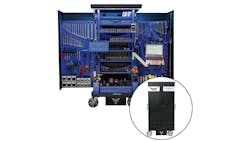Shadow Tool Staging System TSS 6.5
Content brought to you by PTEN. To subscribe, click here.
In each issue of PTEN, we will be featuring one of our Innovation Awards winners that scored amongst the highest in the group. This month, we are profiling the Shadow Tool Staging System TSS 6.5, designed to simplify tool selection/return, saving technicians on time and reducing physical motions while making tool inventory control simple. The TSS 6.5 openly presents tools in dedicated positions, allowing visual cues and barrier-free tool selection. The compact system measures 6'5" height by 30" depth by 36" width and sits on 8" wheels. The unit expands with large panels sliding out to 90" in width, exposing shelves, custom accessories, power (110, USB, 12V), battery charging drawer, plus laptop mounting options.
Amanda Silliker, editorial director of PTEN, sat down with Kelly Tvrdy Benes, CEO and founder of Shadow Tool Company, to learn more about the Shadow system.
Amanda Silliker: What makes this product innovative?
KTB: It’s on large casters, so it can be easily moved to the point of work. The mechanic can move Shadow to whatever they want, be it right behind them or right at their side, so that's also uniquely different. Everything's meant to be within hands reach, so when they expand the system and take those panels out, open the enclosure, it's 7.5’ feet wide at that point. It offers all the different kinds of tool staging devices, whether it be a hanger or hook or shelves — all different types of holders are available inside the system.
It's meant to be barrier free, with the tools being exposed. It only takes two hand motions for a mechanic to reach a tool versus typically six motions to get a tool either out of a drawer or to put it back away. It also provides complete visual tool access, so it provides cues for selecting tools and returning tools. All these things add up to taking time out of mechanics day, but the big benefit it also provides is constant visual tool inventory control. Shadow exposes the tools that mechanics are using on a regular basis, so they can keep track of them as they're already doing a very difficult job — it's kind of nice to alleviate the tracking of the tools.
AS: How did this product come about?
KTB: Shadow came about by addressing a need. A mechanic was getting to be older, and he was kind of tired of taking so many trips over to the wall and where his toolbox was kept, and tracking tools was just a constant battle he had in his in his business, so he developed the original structure for Shadow. I have over 20 years of experience as a co-owner of a business we designed automated equipment for all different types of manufacturing processes and a lot of that involves watching operators trying to make smooth interface between the operator and the equipment itself, and I branched off from them and started a company where I consulted for people if they had inventions or ideas, and they wanted to take them to market, and they needed help with either design or any aspect of patent work, then I would help them.
So I get a call from my brother, and he said, “I have this thing that I think you might want to take to market.” I went to his business, and I saw the first rendition of the shadow system. I spent the next six years redesigning and doing a lot of trials and demonstrations and getting a lot of feedback from a lot of mechanics.
AS: How will Shadow improve the lives of technicians and shop owners?
KTB: It has ergonomic relief. Most of the time savings (30 to 90 minutes a day) is typically based around reducing physical motion, whether it be hand motions or steps, but the reality of it is for the business owner or the mechanic who’s paid per job, that 30 to 90 minutes is a huge impact to the mechanic shortage we have in our country right now. Recapturing those labor hours is going to make a significant impact for the business as far as their customers are concerned, getting more work through their shops, and relieving the actual work being done by mechanics who are making everything happen.
About the Author

Amanda Silliker
Amanda Silliker is the former editorial director of the Vehicle Repair Group at Endeavor Business Media. She oversaw five brands — Motor Age, PTEN, Professional Distributor, ABRN, and Aftermarket Business World. Prior to her tenure with Endeavor, she had over a decade in B2B publishing at Thomson Reuters, ranging from writing and editing content for print and web to managing awards programs and speaking at conferences and industry events. Connect with her on LinkedIn.
